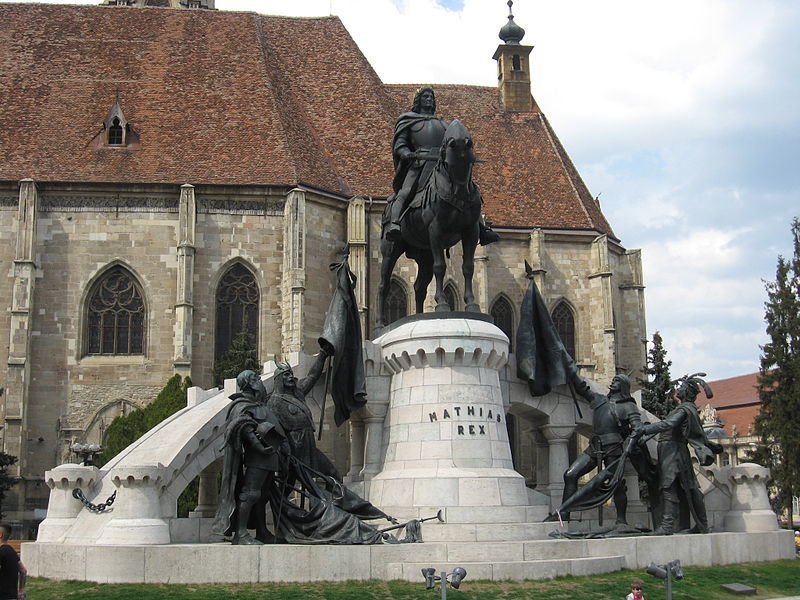23rd of February – The birthday of King Matthias “the Just”
King Matthias I’s (Mátyás in Hungarian) reign is considered by many to be the country’s golden age, and Mátyás himself, born on the 23rd of February, 1443, is one of the most popular historical figures. His cult is based on the legends and tales of Hungarian folklore that present him as Matthias, “the Just” who mingles among the people in disguise to do justice and help the good and the poor, while punishing the bad subjects.
 The king was born in 1443 as the second son of János Hunyadi, the regent of Hungary, and Erzsébet Szilágyi. He was the first king who wasn’t connected to the Árpád dynasty (the greatest Hungarian dynasty) in any ways, not even on spindle-side. At the age of 14 Matthias was imprisoned along with his older brother, László Hunyadi, on the orders of King Ladislaus V of Hungary. László Hunyadi was executed, causing a rebellion that forced King Ladislaus to flee Hungary. (Ferenc Erkel’s famous opera, László Hunyadi, tells this story from a chaotic historic era.)
The king was born in 1443 as the second son of János Hunyadi, the regent of Hungary, and Erzsébet Szilágyi. He was the first king who wasn’t connected to the Árpád dynasty (the greatest Hungarian dynasty) in any ways, not even on spindle-side. At the age of 14 Matthias was imprisoned along with his older brother, László Hunyadi, on the orders of King Ladislaus V of Hungary. László Hunyadi was executed, causing a rebellion that forced King Ladislaus to flee Hungary. (Ferenc Erkel’s famous opera, László Hunyadi, tells this story from a chaotic historic era.)
Matthias I became the King of Hungary and Croatia in 1458, and later he was also elected to be the King of Bohemia and adopted the title Duke of Austria in 1487 as well. Since he was only 15 years old at the time, he began his rule under his uncle’s guardianship, but he took effective control of government within two weeks. He knew no limits and surprised everyone with his hustle as he created a powerful federal authority.
King Matthias generously favoured arts and sciences. He invited famous scientists and renaissance artists to his court. He built castles thus facilitating the development of the renaissance architecture in Hungary. His marriage to Beatrice of Naples strengthened the influence of Italian art and scholarship and it was under his reign that Hungary became the first kingdom outside Italy to embrace the Renaissance. His library of huge codices (Bibliotheca Corviniana) is of outstanding importance.
Still, he is most known for the legends surrounding his figure. Legend has it, that he was a king very interested in the situation of his subjects and he liked to take a stand against the rich and overpowering to help the poor, the simple citizens in their welfare. So much so that he often disguised himself and mingled with his dependents. His identity was only revealed afterwards in a note or by a glimpse of his royal gown. His legendary warm-hearted figure made him so cultic that even a cartoon series was directed to tell his stories. He has a special place in Hungarians’ hearts.
 However, when it comes to the reality of these legends, some points can be doubted. His glorious acts were written down by the humanist historians of his court but there’s no evidence of a king doing justice in disguise. Also, Matthias was loved by neither the folk, nor the lords. The folk didn’t love him for the high taxes that came with his many military campaigns and the lords didn’t like him because he was “only” the son of a lord like them, not the offspring of a dynasty. But at the end of the day, he was a hard-handed king, and Hungary flourished under his reign.
However, when it comes to the reality of these legends, some points can be doubted. His glorious acts were written down by the humanist historians of his court but there’s no evidence of a king doing justice in disguise. Also, Matthias was loved by neither the folk, nor the lords. The folk didn’t love him for the high taxes that came with his many military campaigns and the lords didn’t like him because he was “only” the son of a lord like them, not the offspring of a dynasty. But at the end of the day, he was a hard-handed king, and Hungary flourished under his reign.
Many streets, squares throughout the country, and also the historic church in the Buda Castle are named after him. King Matthias is also depicted on the thousand-forint bill. The ruins of his once glamorous Italian Renaissance style summer palace are now part of an open air museum in Visegrád.
Photo: www.budavarimatyaskiralyjatszoter.hu
Copy editor: bm
Source: Daily News Hungary
please make a donation here
Hot news
Drama: number of births in a 20-year low in Hungary
Yay or nay? – 6 odd Hungarian delicacies that make our skin crawl
Budapest tourism “exploded” this past weekend
Container transport in Budapest may stop: How will this affect Hungarian economy?
Minister: Hungary will protect its territory by every means possible
Orbán cabinet may double airspace fee: another ticket price increase?




